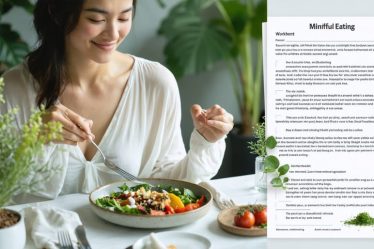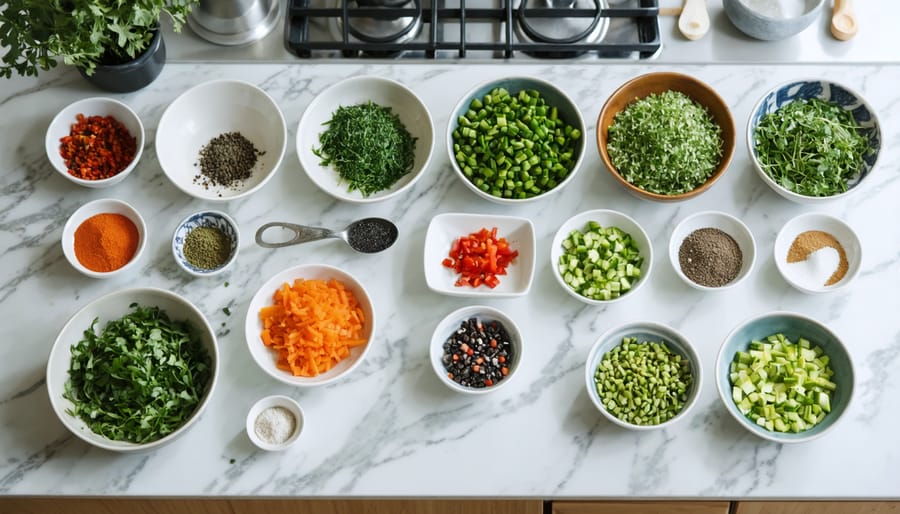
Transform your kitchen into a sanctuary of culinary excellence by mastering the foundational techniques that professional chefs rely on daily. Developing strong mindful cooking habits begins with understanding the symphony of heat, timing, and ingredient preparation.
The difference between good and exceptional cooking lies not in complex recipes, but in the mastery of essential techniques: the precise dance of knife skills, the understanding of heat control, and the art of seasoning throughout the cooking process rather than just at the end. These skills transform everyday ingredients into extraordinary meals.
Whether you’re searing a perfect steak or crafting a delicate sauce, your confidence in the kitchen grows from understanding not just what to do, but why you’re doing it. Let’s explore these fundamental techniques together, breaking down professional methods into approachable steps that will elevate your cooking from routine to remarkable.
Think of culinary technique not as a rigid set of rules, but as a framework for creative expression in your kitchen. When you master these foundational skills, every meal becomes an opportunity to create something truly special.
The Foundation of Conscious Cooking
Mise en Place: The Mindful Cook’s Secret
Have you ever noticed how the most effortless-looking cooking shows start with everything perfectly arranged in little bowls? That’s mise en place, a French term that literally means “putting in place,” and it’s the secret weapon of mindful cooking that can transform your kitchen experience.
I learned this lesson the hard way after one too many frantic cooking sessions, desperately searching for ingredients while my garlic burned in the pan. Now, I start every cooking session by gathering and preparing all my ingredients before turning on the stove. It’s like creating a personal zen garden of measured spices, chopped vegetables, and portioned proteins.
Think of mise en place as meditation in motion. Take those extra few minutes to chop, measure, and organize everything you need. Line up your ingredients in order of use, arrange your tools within arm’s reach, and clear your workspace of clutter. This simple practice not only makes cooking more enjoyable but also helps prevent mistakes and reduces stress.
Remember, cooking mindfully isn’t about racing to the finish line – it’s about savoring the journey, one organized step at a time.
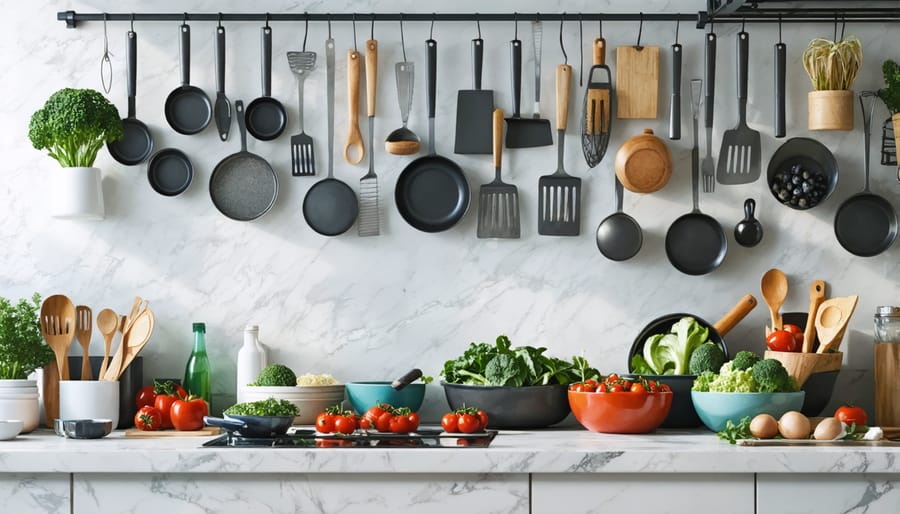
Connecting with Your Ingredients
The heart of exceptional cooking lies in developing a mindful approach to food, starting with your ingredients. I’ve learned that taking time to truly understand what’s in your kitchen can transform an ordinary meal into something extraordinary. When selecting ingredients, engage your senses fully – feel the firmness of an avocado, inhale the aroma of fresh herbs, and notice the vibrant colors of seasonal produce.
Consider each ingredient’s unique properties and how they’ll interact in your dish. For example, understanding that tomatoes contain natural umami can help you build deeper flavors in your cooking. I love running my fingers through different types of rice, noting how arborio’s starchiness makes it perfect for risotto, while jasmine’s fragrant grains are ideal for Thai dishes.
Start small by choosing one ingredient each week to explore deeply. Notice how it responds to different cooking methods, temperatures, and flavor pairings. This intimate knowledge of your ingredients will naturally guide you toward more intuitive cooking and better results in the kitchen.
Essential Mindful Techniques
Mindful Knife Work
I remember the day my grandmother taught me that a knife isn’t just a tool – it’s an extension of your hands and intention in the kitchen. That lesson transformed my cooking, and I’m excited to share these mindful knife techniques with you.
First, let’s talk about the grip. Hold your chef’s knife by pinching the blade near the handle between your thumb and forefinger, with your remaining fingers wrapped around the handle. This “pinch grip” gives you both control and comfort, allowing for precise movements that directly impact your food’s texture and flavor.
When chopping herbs, a sharp, clean cut preserves their essential oils and prevents bruising, keeping their flavors vibrant and fresh. For vegetables, consistent sizing isn’t just about aesthetics – it ensures even cooking and allows each piece to retain its optimal texture and taste. Try the “rock chop” method: keep the tip of your knife on the cutting board while lifting the handle up and down in a smooth, rocking motion.
Remember to let your knife do the work – there’s no need for excessive force. A sharp blade moving through food with intention creates clean cuts that preserve cellular structure, which means better texture and flavor retention in your finished dishes.
Most importantly, take your time. Mindful knife work isn’t about speed; it’s about presence and precision. When you slow down and focus on each cut, you’ll notice the difference in both your cooking process and the final result.
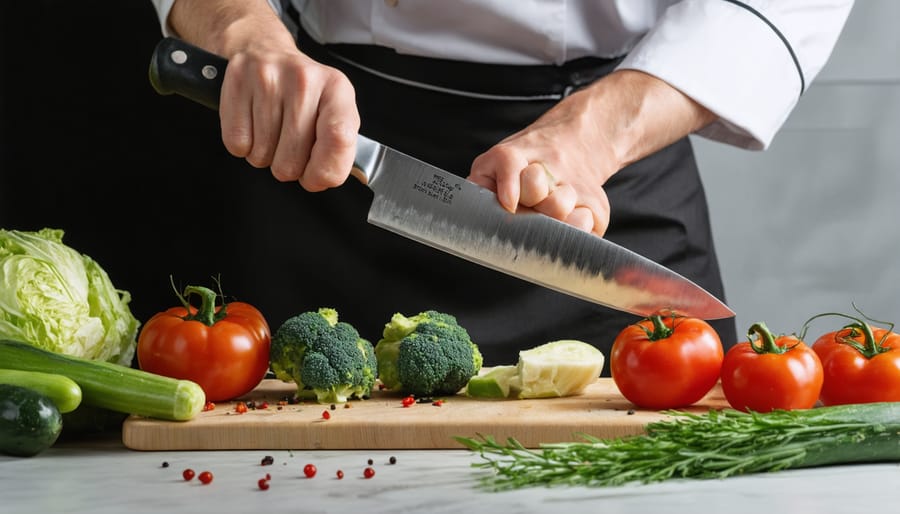
Temperature Control Mastery
Picture this: you’re standing at your stove, and suddenly you realize that mastering temperature is like conducting a delicate symphony. As someone who once burned more meals than I care to admit, I’ve learned that understanding heat is the secret ingredient that transforms good cooking into great cooking.
Think of heat as your kitchen partner – sometimes you need it gentle and slow, like when you’re coaxing flavors out of a hearty stew, and other times you want it bold and fierce, like when you’re searing a perfect steak. The magic happens when you learn to read these temperature signals and respond accordingly.
I love teaching friends this simple trick: hover your hand about six inches above the pan. If you can keep it there for 6-8 seconds, you’re at low heat, 4-5 seconds means medium heat, and 2-3 seconds indicates high heat. This little test has saved countless dishes in my kitchen!
Different ingredients react uniquely to heat. Proteins like meat and fish need high initial heat to develop that gorgeous brown crust, while delicate items like eggs and sauces thrive on gentle, consistent temperatures. The key is matching your heat level to your ingredient’s personality.
Remember, temperature control isn’t just about turning knobs – it’s about building confidence in your cooking instincts and creating dishes that consistently delight your taste buds.
Seasoning with Intention
Seasoning isn’t just about reaching for the salt and pepper – it’s an art that transforms good food into memorable dishes. Think of yourself as a conductor, orchestrating flavors that build throughout the cooking process. I’ve learned that thoughtful seasoning starts before you even begin cooking, as you consider the natural flavors of your ingredients and how they’ll work together.
One game-changing approach I’ve discovered is layering flavors. Start with a foundation of aromatics like onions and garlic, then build complexity by adding herbs and spices at different stages. When practicing healthy cooking techniques, remember that each ingredient brings its own natural seasoning to the dish.
The key is to taste frequently and adjust as you go. I like to think of it as having a conversation with your food – it tells you what it needs if you pay attention. Start with less seasoning than you think you need; you can always add more, but you can’t take it away. Consider how flavors will concentrate as liquids reduce, and remember that some seasonings, like fresh herbs, are best added at the end to preserve their bright flavors.
Don’t forget about balancing elements: a splash of acid (like lemon juice or vinegar) can brighten heavy dishes, while a pinch of salt can actually enhance sweetness in desserts. Trust your palate and don’t be afraid to experiment – that’s how you’ll discover your signature touch in the kitchen.
Bringing Consciousness to Your Kitchen
Creating Your Mindful Kitchen Space
Creating a mindful kitchen starts with intentional organization and a few essential kitchen tools thoughtfully arranged. I’ve learned that a well-organized space isn’t just about aesthetics – it’s about creating an environment that nurtures creativity and focus while cooking.
Start by clearing your countertops of unnecessary items, keeping only what you use daily within arm’s reach. Consider the natural flow of your cooking process: arrange your prep station near the sink, keep cooking utensils close to the stove, and ensure your spices and seasonings are easily accessible.
Lighting plays a crucial role in setting the mood. If possible, maximize natural light during daytime cooking. For evening meal prep, opt for warm, adjustable lighting that illuminates your work areas without creating harsh shadows.
Think about incorporating elements that engage your senses: a small herb garden by the window, a designated spot for your favorite cookbook, or perhaps a bluetooth speaker for your cooking playlist. These personal touches make your kitchen feel more inviting and inspiring.
Remember to create dedicated zones for different activities – mixing, chopping, cooking, and plating. This not only makes cooking more efficient but also helps maintain mindfulness throughout the process. When everything has its place, you can focus more on the joy of cooking and less on searching for misplaced items.
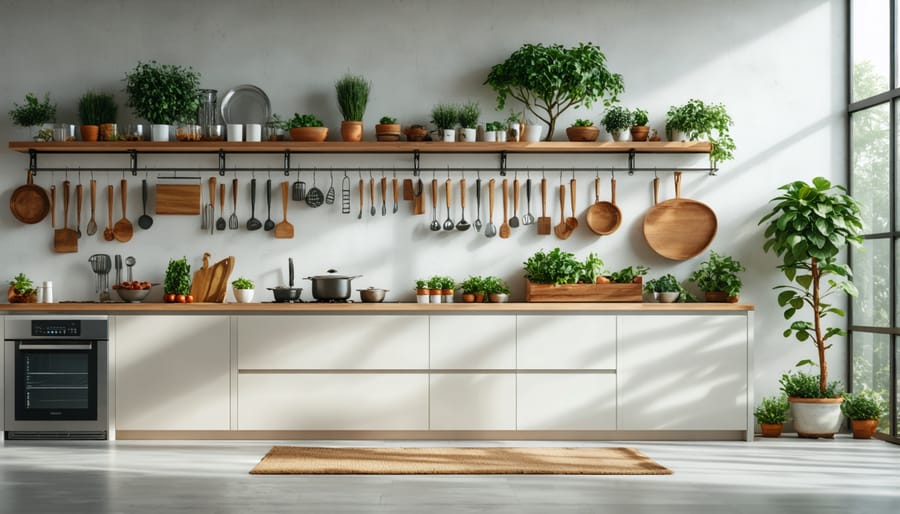
Daily Practice Tips
Every time I step into my kitchen, I remind myself that great cooking isn’t just about following recipes – it’s about being present and mindful in the process. Here are some simple ways to incorporate thoughtful culinary techniques into your daily cooking routine.
Start by organizing your workspace before cooking – what the French call “mise en place.” Take a few minutes to gather all ingredients and tools you’ll need. This small step makes a world of difference in creating a stress-free cooking experience.
Practice mindful knife work by focusing on consistency rather than speed. When chopping vegetables, try maintaining even sizes – this isn’t just about presentation, it ensures everything cooks uniformly. I learned this lesson after years of wondering why some pieces in my stir-fry were perfectly done while others remained raw!
Train your senses to be more aware. Listen to the sizzle of a pan to gauge temperature, observe how ingredients change color and texture, and trust your nose to tell you when garlic is perfectly golden. These subtle cues are your best cooking guides.
Make tasting a deliberate practice. Before seasoning, take a moment to really experience the flavors. What does the dish need? Is it calling for more acid, salt, or perhaps a touch of sweetness? This thoughtful approach will gradually develop your palate and intuition.
Remember, every meal is an opportunity to practice and improve. Even simple tasks like scrambling eggs can become a meditation in technique when approached with intention and awareness.
As we wrap up our culinary journey together, I hope you’ve discovered that conscious cooking is more than just following recipes – it’s about creating a mindful, enjoyable experience in your kitchen. Throughout this guide, we’ve explored how paying attention to ingredients, mastering fundamental techniques, and staying present during the cooking process can transform your relationship with food and elevate your culinary results.
Remember, becoming a more conscious cook doesn’t happen overnight. Start small by implementing one or two techniques we’ve discussed, perhaps beginning with mise en place or focusing on proper knife skills. As these practices become second nature, you can gradually incorporate more mindful approaches into your cooking routine.
I’ve seen firsthand how this transformation can impact not just the quality of meals, but also the joy we find in preparing them. One of my readers recently shared how simply taking the time to properly heat her pan before cooking has revolutionized her stir-fry game – it’s these small, mindful adjustments that make the biggest difference.
The beauty of conscious cooking lies in its accessibility – you don’t need fancy equipment or professional training to get started. What you need is presence, patience, and a willingness to learn. Pay attention to how ingredients react to heat, listen to the sounds of cooking, and trust your senses. These natural cues will guide you toward becoming a more intuitive cook.
I encourage you to view each cooking session as an opportunity for growth and enjoyment. Take notes on what works well, experiment with new techniques, and most importantly, be patient with yourself as you develop these skills. Remember that even the most experienced chefs started exactly where you are now.
Let’s make our kitchens spaces of creativity, mindfulness, and joy. Your conscious cooking journey starts now – what will you create first?


